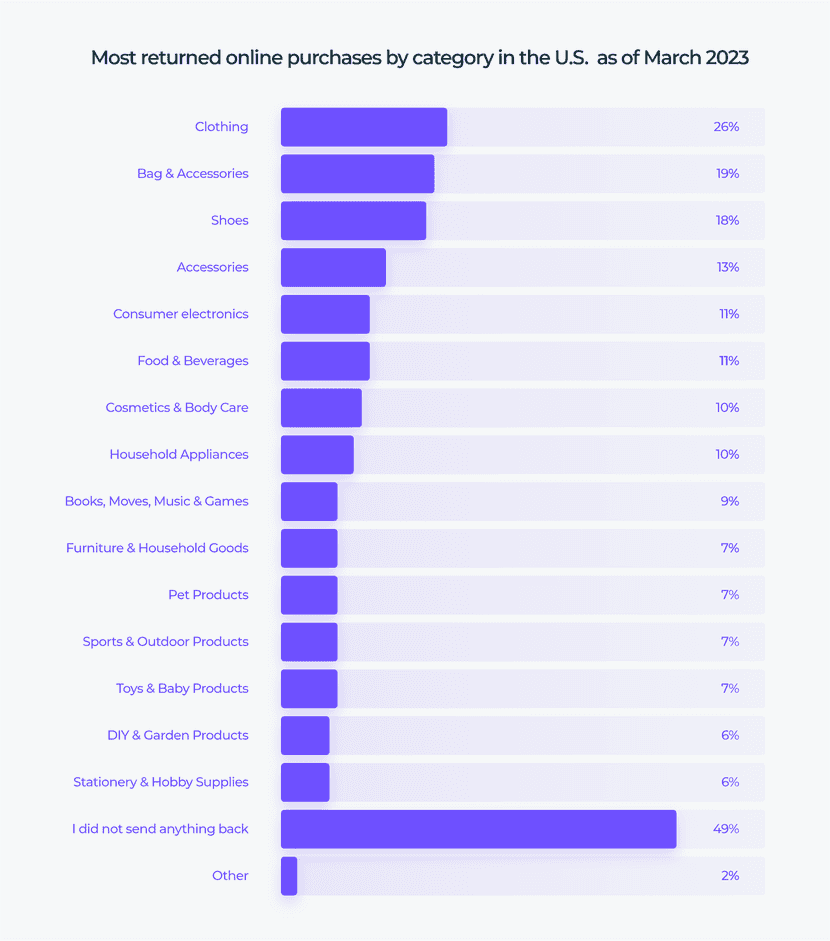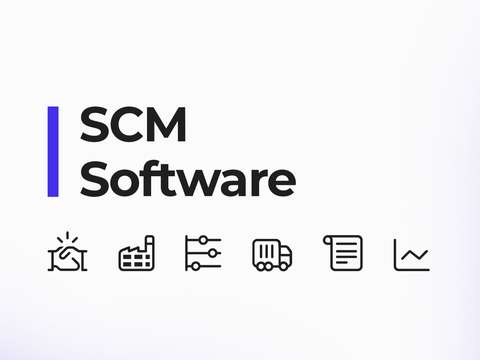The return rate in eCommerce continues to be a key metric to monitor, as it can highlight potential issues at various stages of the user journey, spanning from advertising to shipping. To effectively manage this, the need for specialized eCommerce returns software becomes evident, helping businesses streamline the process and gain valuable insights.
At Outvio, we encourage online stores to place more emphasis on monitoring their return rates and to conduct in-depth analyses from various perspectives.
Let's delve into this interesting topic.
What is the eCommerce return rate?
The return rate indicates the percentage of returned items in eCommerce. While it may initially seem like a straightforward and perhaps less eye-opening metric, we would like to present it from a different perspective.
First and foremost, it's important to recognise that returns are a common practice, especially in online shopping. Customers may occasionally make a slight mistake when selecting a product without the opportunity to try it out, relying solely on the description provided in the online store.
Staying aware of the average return rate of your eCommerce category and continually enhancing the quality of your return process is a good idea, especially since numerous studies indicate that customers are more likely to order from online stores with a clear and simple return process.
eCommerce Return Rates by Category
According to Statista's latest data, each eCommerce category exhibits distinct return rates, with an industry-wide average of 20%. The clothing & apparel category in U.S. processes the majority of returns, leading the list with a 26% return rate.
On the other end of the spectrum, hobby supplies and garden product categories demonstrate a minimal return rate of 6%. Less than half of all shoppers (49%) say they have not returned any of the products they bought online during 2023.

Understanding these industry benchmarks is essential for tailoring your strategies accordingly. Setting unrealistic return rate targets that fall outside your industry's norms can result in inefficient investments and impede business expansion.
How to Calculate the Return Rate
To calculate the return rate you need to know:
- The number of returns you have received.
- The number of sales you have made.
And use the Formula:
Return Rate = (Number of Returns / Number of Sales) * 100
For example, if you have received 100 returns and made 10,000 sales, your return rate would be 1%:
- Return Rate = (100 / 10,000) * 100
- Return Rate = 1%
Analizing return rate to enhance eCommerce success
As mentioned earlier, the return rate offers more than just the frequency of returns in your online store. By filtering data across various dimensions and comparing return rates in multiple reports, you can extract valuable insights. Here are some examples of how you can leverage this data to foster the growth of your business:
Overall industry benchmark
As you have seen, the average return rate for eCommerce businesses varies depending on the industry and product type. However, a general rule of thumb is that a return rate of 15%-20% is considered acceptable. If your return rate is significantly higher than this benchmark, it indicates potential areas for improvement and deeper investigation.
For example, if you experience an immediate spike in the return rate on your online store, the first thing we suggest is to determine which type of users are causing it—whether new users or returning customers. If the increase in return rate is caused by new users, it might indicate a low quality of traffic from recent campaigns.
If most returns are made by returning customers or both, then you should inspect the condition of your products. Perhaps you have received a defective batch of goods in your warehouse.
Additionally, if you observe a spike in returns for a specific product, it could mean that your competitors are promoting discounts for the same product type and thus causing your customers to simply switch retailers - a practice quite common in the electronics industry.
Return reasons
Tracking the reasons for returns can be a valuable data source for improving eCommerce revenue. By analyzing return rates for each reason, you can identify the primary causes of returns. For example, if sizing issues are prevalent, consider adding a more comprehensive size chart to your website or placing it more prominently for easy access.
If clients frequently complain about damaged items, it's a signal to check your fulfilment and shipping process. You might even consider changing your shipping company to enhance the security of your parcels.
High return numbers due to "poor quality" can on the other hand indicate that your product images are not informative enough, and fail to accurately represent the actual product. Alternatively, if a specific product is consistently returned due to poor quality, it could serve as a valuable signal for your purchasing manager, suggesting that it might be prudent to exclude that product from your online shop to avoid unnecessary expenses on returns.
Compare return rates in different product categories
Analyzing return rates across different product categories to identify any outliers can help you pinpoint product-specific issues and strategically adjust your advertising spend.
For instance, filter the products or product categories with the lowest return rates and consider increasing the advertising budget for those specific products. Additionally, you may want to decrease budgets or even stop active advertising for products with high return rates.
Spending money on advertising products with a high return rate results in increased operational costs without generating profit. Essentially, you end up paying for ads that might seem on paper profitable but in reality contribute only to increasing expenses. By conducting a simple analysis of return rates, you can uncover such inefficiencies and allocate your advertising budget more effectively.
Recommend to read
Unlock latest strategies and insights about return management by reading our comprehensive guide.
eCommerce statistics and insights 2025
Returns have become an integral part of the shopping experience
Returns have become an essential part of the customer experience in Retail. According to data provided by the National Retail Federation, returns play a significant role in retail, representing a notable 16% of the total dollar value of retail sales in the United States.
This trend is even more amplified in the eCommerce ecosystem, where, according to the InvespCRO portal, the return rate has already reached 30% of the sales revenue. While return rates may vary across different sectors, it's indisputable that while eCommerce is growing, returns are also on the rise, directly affecting profit margins and customer satisfaction.
While many online stores view returns as lost sales, at Outvio, we consider returns as a valuable opportunity to potentially increase revenue and enhance connections with consumers. For example, we recommend promoting exchanges over traditional returns as a tactic to make returns work for your benefit.
By offering incentives for exchanges, businesses can encourage customers to retain their original purchase, potentially avoiding the need for a full refund and maximizing revenue potential. Additionally, successful product exchanges increase the likelihood of repeat purchases from the same store.
Meeting consumer expectations: seamless and hassle-free returns
In the current eCommerce environment, customers expect a seamless and hassle-free return process. An astounding 92% of consumers prioritize easy returns, emphasizing the significance of convenience. Moreover, 79% of consumers consider free return shipping as non-negotiable, underscoring their preference for effortless and cost-effective returns.
To remain competitive in eCommerce, businesses must rethink their approach to returns, prioritizing speed and simplicity for end customers. This is why many online stores are turning to return automation software and promoting their free return policy. As indicated by the aforementioned research, this aspect is a crucial factor for many customers when making a purchase. Free returns instill a sense of security in customers, knowing they can return a product if it fails to meet their expectations.
This feature has emerged as a decisive factor for many customers, including those who have never initiated returns before. Therefore, a seamless and convenient return process is not only a customer service necessity but also a strategic investment in fostering customer loyalty and attracting new consumers.
Value of the returns policy page
Returns policy plays a crucial role in the purchase decision-making process. Surprisingly, 67% of consumers carefully review return policies before making a purchase. We believe this percentage may be lower in reality, but even if only one in ten customers checks your return policy, it still indicates that for a significant group of people, it's a crucial step.
PRO TIP
You can utilize web analytics, like GA4, to track the number of sessions on your return policy page and measure the exit rate of that specific page. This will indicate how many users engage with your return policy and how many of them leave your website after reading it.
Another insightful study conducted by the Baymard Institute reveals that cart abandonment rates in 2025 remain high, averaging at 70.19%, with 16% of that attributed to unsatisfactory return policies. Consequently, enhancing your return policy could potentially attract more customers to finally complete that checkout.
So make sure to explore the best practices for crafting an eCommerce return policy that enhances customer satisfaction, preserves sales, and safeguards your online store from fraud. And don’t overlook your return policy page. Ensure it is updated regularly and easily accessible to your customers.
In-store returns are becoming more common
The coexistence of different sales channels has generated the need to offer a sufficient variety of return options to meet the changing demands of consumers.
In this regard, consumers show a clear preference for returning items in physical stores, with 62% expressing their inclination for this alternative. This highlights the importance of a smooth integration between online and offline channels to enhance the customer experience. Retailers can capitalize on their physical stores as return centres, providing convenient and accessible return options for customers.
Therefore, e-commerce businesses must prioritize improving their reverse logistics operations and incorporate in-store returns into their strategies. eCommerce return statistics demonstrate that this approach is highly profitable and essential to ensuring a positive shopping experience.
Personalization and self-service
In today's customer-centric realm, personalized interactions and self-service options are key to delivering exceptional online experiences. A significant 71% of consumers prefer personalized interactions, demonstrating their desire for tailored communication and assistance in selecting products or services when they are in buying mode.
According to the same research by McKinsey, people not only expect but also rely on personalized ads. A notable 76% of respondents expressed frustration when personalized interactions don't occur. Here are some key insights into what consumers value and expect from effective personalized marketing:
- New ideas and recommendations: Contrary to common perceptions about online ads, customers actually appreciate receiving recommendations for products or services that align with their browsing or purchase history. As long as these recommendations are relevant and not overly frequent, customers find them valuable in enhancing their online shopping experience.
- Good timing: Studies indicate that shoppers who have recently visited either a physical or online store exhibit a higher likelihood of opening and responding to messages delivered on the same day or precisely one week later.
- Reminders: Customers highly value personalized interactions that facilitate tracking of products they are interested in. This can involve notifying a customer when a desired item is restocked or when a new style is introduced for a product the shopper has previously purchased.
- Full synchronization: Customers have high expectations for seamless communications that bridge offline and online experiences. Achieving this poses a challenge for retailers as it necessitates collaboration across various sectors of the organization, ranging from store operations to analytics.
Another notable trend has emerged in recent decades: the increasing prevalence of introverted behaviour among shoppers. Each year, the number of online purchases surpasses those made in brick-and-mortar stores, and this trend continues to increase annually.
Similarly, the use of specialized apps for food and taxi ordering is becoming increasingly popular and efficient compared to traditional phone orders. These changes in consumer behaviour are reshaping our everyday habits and expectations across various aspects of life.
A study conducted by Nice in 2022 revealed that 81% of consumers prefer self-service options, underscoring their desire for control and convenience. By providing self-service return options, eCommerce businesses can empower customers to manage their returns independently, at the same time reducing the workload on customer service teams. Moreover, it allows clients to complete the process at their preferred time and significantly speeds up the process, because it doesn't require the involvement of other people.
Vulnerability to fraud
According to data from SEON, most fraudulent returns occur in December, particularly during the holiday shopping season. Specifically, the fraud detection company identified and rejected 2,281,668 suspicious transactions between November 30 and January 6. They also highlight that the days of greatest risk are December 5, 12, 13, 14, and 15, which aligns with the busiest commercial period of the year.
Additionally, the Fraud Fighter portal reports that approximately 3% of holiday returns were fraudulent, with expectations of this figure rising to 3.5% this year.
Regarding return methods, 48% of return fraud occurs with in-store returns. This presents a unique challenge for businesses, requiring careful planning, resource allocation, and effective fraud prevention measures.
Minimizing costs and risks
High inflation rates have a noticeable effect on the retail industry, ramping up competition and driving down average order values. Over the past few years, consumers have been tightening their belts, spending less on shopping and making more returns. This shift is putting pressure on the eCommerce sector, prompting companies to streamline operations to stay profitable.
Retailers face economic challenges that extend beyond refunds and lost repeat sales. Notably, reverse logistics costs alone consist of transportation, processing, discount and liquidation loss, and customer support overheads, which can conservatively amount to a 59% of the sale price of a $50 item.
Online retailers also encounter ongoing logistical challenges in product packaging. A significant 38% of them see this process as an additional expense, adding complexity to return management.
To address these challenges effectively, many online retailers turn to platforms like Outvio to optimize operations and reduce expenses. Outvio facilitates seamless processes, allowing stores to offer refunds in certain cases without necessitating the return of the item, particularly when it arrives damaged. In instances where a product sustains significant damage during transit and cannot be repaired economically, it can be more cost-effective to do just that and forgo returning the item.
Moreover, Outvio offers the capability to tailor workflows for individual products and reasons for return. For instance, if a product incurs repairable damages, automation can ensure that such returns are directed to a designated warehouse for repairs rather than burdening the online store with the logistics.
Technological adoption
The adoption of self-service return portals and return automation technology is a testament to the industry's dedication to technological innovation. As Statista reports, 48% of retailers are implementing these technologies, highlighting their commitment to streamlining return processes and enhancing customer satisfaction.
However, this means that still over half of online shops are yet to adopt these tools that guarantee significant cost-cutting and reduction of errors. We predict that the adoption rate of such self-service automation tools will only increase in the coming years and will inevitably lead to industry-wide adoption in the near future. Businesses that have a clear vision and understanding of the challenges the industry will face in the future are already leading the way for these changes.
That's why forward-thinking companies are already investing in building technologies that will help reduce costs and increase productivity in the future through innovative and comprehensive e-commerce solutions. This is precisely our focus at Outvio. We closely monitor industry trends and consider various factors to develop a user-friendly product that evolves according to the changing needs of our customers.
Driving Engagement Through Shared Goals
Another trend we see is that many online stores effectively attract additional customers by fostering shared goals and interests with them. In a world that is constantly exposing and sharing more on social media, the next generations are looking for openness and meaning. This strategy encourages a sense of collective responsibility, motivating customers to actively engage in a common endeavour for the greater good.
This means that CO2 neutral shipping and returns, reusable and recyclable packaging materials and using environmentally conscious couriers as part of the delivery and returns processes are increasingly becoming key factors influencing consumer decisions.
Here is how it works: Some online retailers actively engage in charitable initiatives or support environmental conservation, some plant a tree with each order processed, while others sell clothes made from plastic collected from the ocean. As part of this commitment, they transparently share earnings data and actively involve every customer in these philanthropic endeavours.
By showcasing the percentage of proceeds from each purchase dedicated to noble causes, they empower customers to contribute positively with their purchases. This transparent approach often serves as a powerful incentive for customers to choose these stores for their purchases. Consequently, customers leave with a sense of fulfilment, knowing that their purchases have made a positive impact on someone's life or contributed to the preservation of nature and this in turn leads to lower returns and more conscious shopping.
The latest research shows that younger generations place a significantly higher value on environmental issues. Gen Z's preference, and willingness to even pay more, for sustainable return and shipping methods highlights the growing consumer demand for eco-friendly practices in eCommerce. Businesses that integrate sustainability into their operations stand to gain a competitive edge by appealing to environmentally conscious consumers.
Summary: 21 eCommerce facts and stats
Let's consolidate our findings and extract key insights gathered from a variety of sources, including Statista, the National Retail Federation, SEON, and Outvio.
- Returns represent a significant 16% of total retail sales (online and offline) in the United States.
- Around 20% of products ordered online in the U.S. end up being returned back to the online store.
- Consumers crave hassle-free returns policies, with 92% of consumers surveyed stating their willingness to repurchase from a retailer with a positive return experience.
- Consumers demand free return shipping as a standard practice, with 79% of consumers favouring this option.
- Shoppers actively scrutinize the return policy before finalizing a purchase, with 67% of shoppers giving it careful consideration.
- Shoppers prioritize easy-to-print return labels for a frictionless return experience, with 47% prioritizing this factor.
- Shoppers are more inclined to shop online if they have the option to return items at physical stores, with 62% of shoppers stating this preference.
- Personalized return experiences are important to consumers, with 71% seeking individualized interactions.
- Consumers prefer self-service options for handling returns, with 81% expressing a preference for this approach.
- Holiday return rates consistently hover around 17.9% annually.
- Buy online, return in-store fraud is projected to be 48% higher compared to non-store return fraud.
- A significant 22.1% of returns occur without a receipt, and an estimated 14% of these cases are considered fraudulent.
- Clothing tops the list of high-return items, with a return rate of 26%, followed by bags and accessories at 19% and shoes at 18%.
- Damaged or broken items account for 25% of returns, while items not fitting properly contribute 24%.
- The total cost of transporting and restocking a $50 returned item can reach approximately 59% of the selling price.
- For every $100 of returned merchandise, retailers lose an average of $10.30 to fraud.
- Repackaging is a major pain point for online shops, with 38% of respondents identifying this factor as a major challenge.
- Gen Z is the most likely generation to shop with a brand or retailer offering more sustainable return and shipping methods.
- In 2022, 47% of retailers planned to add an online returns portal, while 48% intended to incorporate returns-processing technology.
- Additionally, 40% of companies surveyed planned to add new return drop-off points.
- The highest-risk dates for fraud are December 5th, 12th, 13th, 14th, and 15th.
Conclusion
In conclusion, the eCommerce landscape continues to evolve, with returns serving as a crucial aspect of the customer experience. By monitoring return rates and conducting thorough analyses, online retailers can uncover valuable insights to enhance their operations and better serve their customers. Embracing sustainability, prioritizing seamless returns processes, and leveraging technological advancements are key strategies for success in this dynamic environment.
As businesses navigate the complexities of returns management, platforms like Outvio offer tailored solutions to optimize processes, reduce costs, and drive engagement with consumers. By embracing shared goals, fostering a sense of collective responsibility, and aligning with consumer values, online stores can not only meet but exceed customer expectations while making a positive impact on society and the environment.




